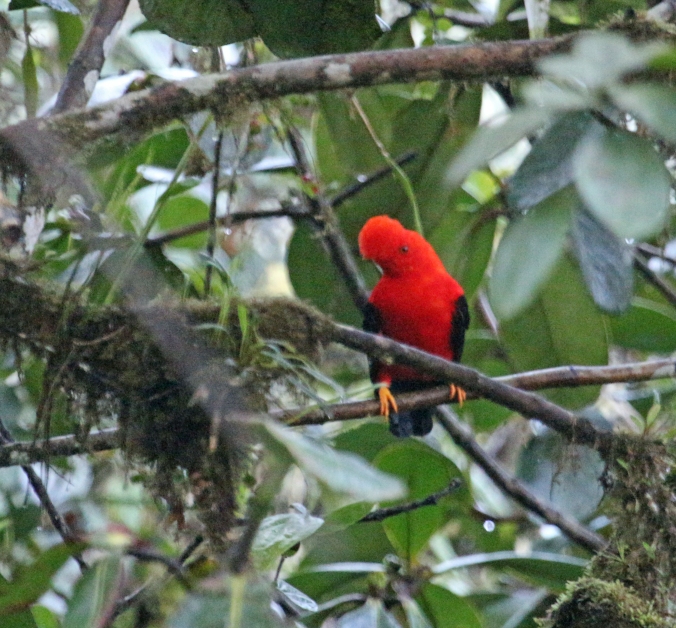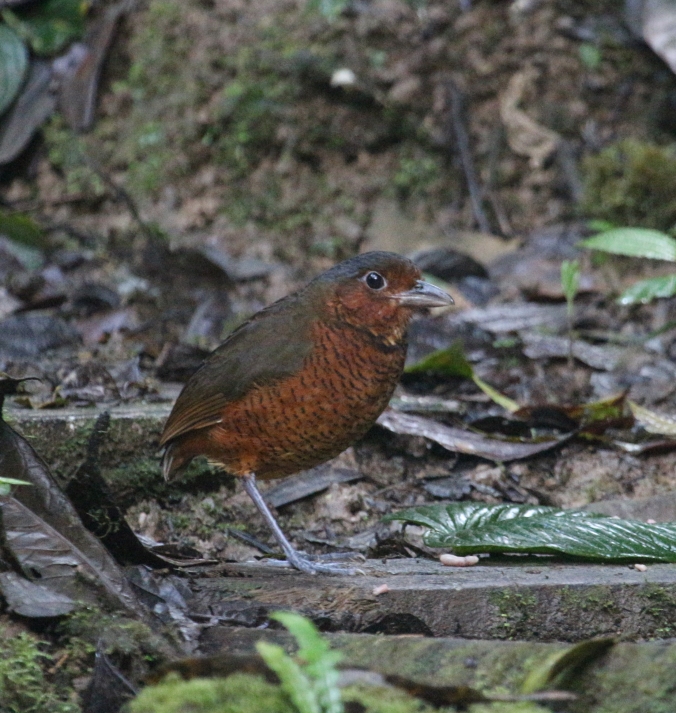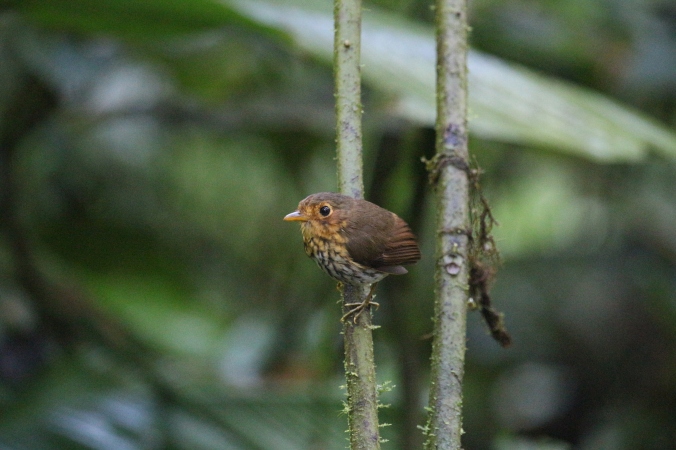I first heard about the Refugio Paz de Las Aves — which translates as Birds of Peace Refuge — from Noah Strycker, an ornithological writer and big year birder at a talk he gave at the Biggest Week in American Birding Festival in Ohio in 2016. He told the story of a man in north-west Ecuador who had trained rare, strange looking, tropical birds to come out when he called them. It sounded amazing to me, but I had no idea that only two years later I would be going to the same place.
I watched the shadows of the predawn forest from a bamboo blind, eagerly waiting for my first views of an Andean cock-of-the-rock at the Refugio Paz de Las Aves lek. Andean cock-of-the-rocks are one of the many species of birds that form communal displays, called leks, where multiple males gather to display for females. In most species of birds that lek, the males don’t help with nesting or raising the young, but they sure do put on a show.
As the sky began to lighten, I heard faint croaking noises coming from the trees. The sun rose, revealing five or six huge, striking, red birds with black and white wing patches in the trees in front of the blind. They began to jump and flap their wings while making loud squawking calls.

Andean Cock-of-the-rock (Rupicola peruvianus)
Once the sun had completely risen the cock-of-the-rocks continued to display, although a little less vigorously. Apparently, if a female were to show up, they would go crazy with their displays again. We took a last look at them, and walked up the path out of the forest. A brilliantly green bird with a red breast, a golden-headed quetzal, flew over us and landed in a tree. As we emerged from the forest onto a dirt road, clouds drifted overhead. I thought I caught a glimpse of a swift in the clouds several times, but it would always disappear before I could identify it. The founders of Paz de las Aves, Angel and Rodrigo Paz, met us at the road, and than disappeared into the forest to look for the giant antpittas Angel had trained.
Antpittas are a very secretive family of large tropical birds that like to hop around in dense brush and eat worms. The giant antpitta, especially, is a skilled hider, and on top of that, a very rare, range-restricted Choco endemic. Landowner Angel Paz didn’t know this information, though, when he first noticed a giant antpitta eating worms on a recently made trail years ago. He had already discovered the cock-of-the-rock lek on his land, and begun showing it to tourists. Angel spent the following days studying the bird, learning about its habits and what it ate. He tried feeding it worms, but at first it wouldn’t accept them. Finally, one day the bird ate the worms he offered. He named her Maria, and trained her to come out whenever he called in exchange for worms. When he realized that there were other species of antpittas on his property, such as chestnut-crowned, yellow-breasted, ochre-breasted and mustached, he worked on training those as well. Now birders travel from all over the world to see Maria and the other antpittas, and he makes a much better living from conserving the forest and all the species that depend on it than he ever did logging it, as he once did.
We stood in the road listening to the loud low whistles of Angel’s imitations of the giant antpitta’s call. Our guide said that the antpittas were not as reliable in the rainy season, because it was easier for them to get worms on their own. Despite his pessimism, I began to hear a whistled response to Angel’s imitations. Sometimes the antpitta’s call was just barely audible above the chorus of frog noises, and sometimes it seemed like the bird might hop out into the path at any moment. Just when the bird began to sound particularly close, a motorbike roared by, and it didn’t respond again for several minutes. Finally, after almost an hour of tense waiting, a large bird with a rufous belly barred with black, and a big, thick, bill hopped out onto the path where Angel had set down worms.

Giant Antpitta (Grallaria gigantea) Angel told us this bird was Maria’s mate.
I watched with fascination as the giant antpitta ate, thinking about how so many birders, including Noah Strycker, had seen this bird or his mate before me. Eventually, he finished his worms, looked up at us for the last time, and hopped back into the forest.
We continued up the road, where Angel had once again disappeared into the woods. When we arrived at the end of a dirt trail off the road, Angel and Rodrigo were waiting with a family of dark-backed wood quail eating a banana. Dark-backed wood quail are another secretive endemic that was nearly impossible to see with any certainty until Angel trained them to come out.

Dark-backed Wood Quail (Odontophorus melanonotus) This is a link to a video I took of the wood quail family on youtube: https://youtu.be/AvA-ufjqlxA
The wood quail and their chicks ate the banana voraciously within three or four feet of us before slowly wandering down the slope.
The next stop, on a steep, densely wooded hillside, was to see the yellow-breasted antpitta. Angel called for it, and threw worms into a clear space amid a tangle of branches and roots below us. It wasn’t long before a small, brown-backed, yellow-breasted bird emerged from the brush, and started gobbling down the worms.
We walked through the Paz de las Aves lodge and past signs saying “ochre-breasted and mustached antpittas that way” and onto a trail that followed the top of a bluff into the forest. We followed the trail down the steep, muddy slope of the hill. Monkeys hooted and climbed in the huge palms in the distance. Eventually the trail leveled out, and we stopped to call for the ochre-breasted antpittas. We soon saw three of these tiny, adorable antpittas eating worms and hopping on the sticks in front of us.

I believe this individual Ochre-breasted Antpitta (Grallaricula flavirostris) was named Chiquira.
As the ochre-breasted antpittas began to retreat into the forest, Angel began throwing nuts he had picked up earlier onto the ground. Apparently, the mustached antpitta that he had trained, named Jose, was attracted by the noise of the nuts hitting the ground. Jose soon appeared, hopping with much more dignity than the tiny ochre-breasted antpittas, who backed up to let him pass.

Jose the Mustached Antpitta (Grallaria alleni)
We took our final looks at the antpittas and walked back toward the lodge, where we had a delicious breakfast of mashed and fried green bananas filled with cheese and empanadas. While we ate, we watched toucan barbets and blue-winged mountain-tanagers eat at a banana feeder. Violet-tailed sylphs, velvet purple coronets, and fawn-breasted brilliants buzzed and swooped around the hummingbird feeders.
Paz de las Aves shows how effective ecotourism can be as a conservation tool. Now, instead of logging patches of forest, planting crops, and then moving on to the next forest — while there is still forest left to clear– Angel and his brother can conserve the area just by being able to show a couple of birds to visitors. Not only is Paz de Las Aves financially important for the Paz family, but it’s one of the main attractions in the wider Mindo region, where visiting birders and other tourists spend money on numerous goods and services.
Another entertaining blog – thanks for bringing these stories and birds to us Ezra!
LikeLike